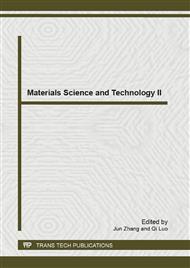[1]
H. Ping, Spatial compounding in 3D imaging of limbs, Ultrasonics Imaging, 19: 251–265, 1997.
Google Scholar
[2]
P. Liu and D. C. Liu, Directive Filtering Schemes for Frequency Compounding in Ultrasound Speckle Reduction, in Proc. International Pre-Olympic Congress on Computer Science: 227–231, 2008.
Google Scholar
[3]
J.W. Luo and Elisa E. Konofagou, A Fast Normalized Cross-Correlation Calculation Method for Motion Estimation, IEEE Trans. Ultrason. Ferroelectr. Freq. Control, 57(6), 1347–1357, 2010.
DOI: 10.1109/tuffc.2010.1554
Google Scholar
[4]
F. Viola, W. f. Walker, A comparison of the performance of time-delay estimators in medical ultrasound, IEEE Trans. Ultra-son. Ferroelectr. Freq. Control, 50(4): 392–401, 2003.
DOI: 10.1109/tuffc.2003.1197962
Google Scholar
[5]
S. Langeland, J. D'hooge, H. Torp, et al, comparison of time-domain displacement estimators for two-dimensional RF tracking, Ultrasound Med. Biol., 29(8): 1177–1186, 2003.
DOI: 10.1016/s0301-5629(03)00972-4
Google Scholar
[6]
M.G. Strintzis, I. Kokkinidis, Maximum likelihood motion estimation in ultrasound image sequences, IEEE Signal Processing Letters, 4(6): 156-157, 1997.
DOI: 10.1109/97.586034
Google Scholar
[7]
A. Basarab and P. Gueth, H. Liebgott, and P. Delachartre, Phase-based block matching applied to motionestimation with unconventional beamforming strategies, IEEE Trans. Ultrason. Ferroelectr. Freq. Control, 56(5): 945 – 957, 2009.
DOI: 10.1109/tuffc.2009.1127
Google Scholar
[8]
Y. G. Zhou and Y. P. Zheng, A motion estimation refinement framework for real-time tissue axial strain estimation with freehandultrasound, IEEE Trans. Ultrason. Ferroelectr. Freq. Control, 57(9): 1943–1951, 2010.
DOI: 10.1109/tuffc.2010.1642
Google Scholar
[9]
G. Wang and D.C. Liu, Adaptive persistence utilizing motion compensation for ultrasound images, IEEE 18th Int. Conf. on Pattern Recognition, vol. 3, : 726-729, 2006.
DOI: 10.1109/icpr.2006.221
Google Scholar
[10]
X.Y. Li, Dong C. Liu, Dynamic persistence of ultrasound images after local tissue motion tracking, IEEE 3rd Int. Conf. on Bioinformatics and Biomedical Engineering: 1–4, 2009.
DOI: 10.1109/icbbe.2009.5162670
Google Scholar
[11]
K. He, J. Sun, and X. Tang, Guided image filtering, accepted by IEEE Trans. on Pattern Analysis and Machine Intelligence, 2012.
Google Scholar


